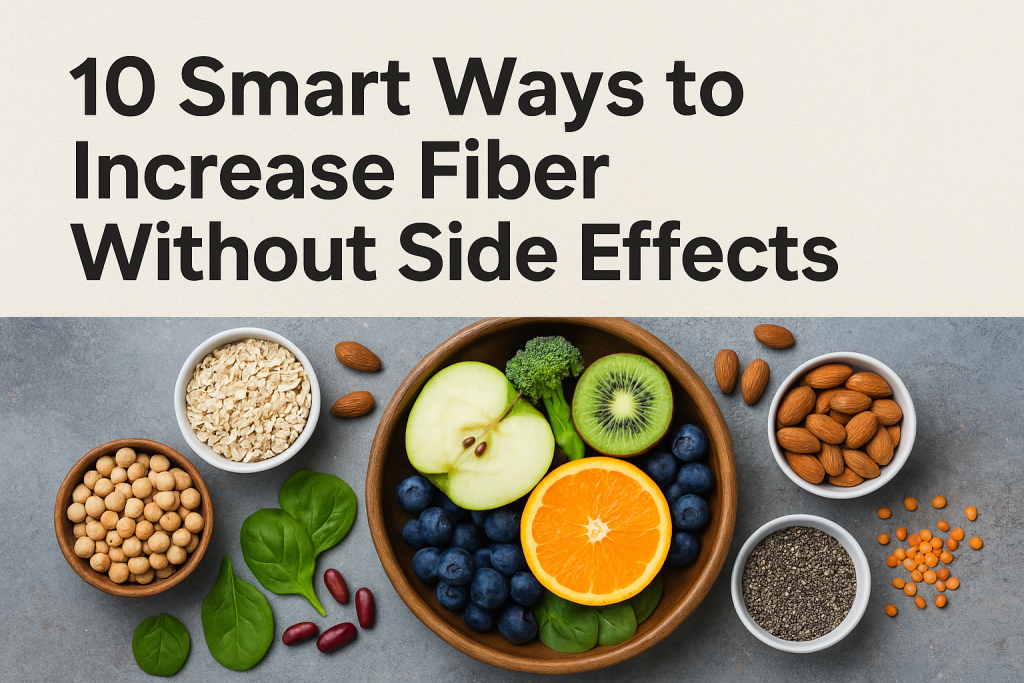Start Slow: The Best Way to Increase Fiber Without Side Effects
One common mistake is adding too much fiber too quickly, which can lead to bloating and cramps. Instead, increase fiber gradually over one to two weeks. Begin by adding one high-fiber food each day, such as fruits or vegetables, and give your body time to adjust before adding more.

Drink Water to Support Fiber Intake
Water and fiber work together for smooth digestion. Fiber absorbs water, which helps prevent constipation. Aim for at least eight glasses of water daily, or more if you’re active. For every 5 grams of added fiber, add an extra glass of water to stay hydrated and reduce digestive discomfort.
Whole Foods Over Supplements: A Healthier Fiber Boost
While fiber supplements are convenient, whole foods provide additional nutrients and antioxidants. Focus on fiber-rich foods like fruits, vegetables, legumes, and whole grains. These natural sources are better for digestion and overall health when introduced gradually.
Breakfast Hacks to Increase Fiber Without Side Effects
Breakfast is an easy meal to add fiber to. Try oatmeal topped with chia seeds and berries, whole-grain toast with avocado, or smoothies with spinach, banana, and flaxseeds. These options provide soluble fiber, which is gentler on the stomach.
Snack Smart for Better Digestion
Healthy snacking is another simple way to add fiber. Swap processed snacks for nuts, seeds, air-popped popcorn, or raw veggies with hummus. These choices help you feel full and support healthy digestion.
Legumes Done Right: How to Avoid Discomfort
Legumes are an excellent fiber source but can cause gas if not prepared properly. To reduce this, soak beans overnight and cook them thoroughly. Start with small servings and choose lentils or split peas, which are easier to digest than larger beans.
High-Fiber Fruits That Are Easy on the Stomach
Fruits provide fiber and antioxidants. Choose whole fruits instead of juice and keep the skin on when possible. Apples, pears, berries, kiwi, and oranges are excellent options. Spread your fruit intake throughout the day to avoid sudden digestive changes.
Seeds for Fiber: Chia, Flax, and More
Seeds are fiber-rich and easy to incorporate into your diet. Add a tablespoon of chia or flaxseeds to smoothies, salads, or oatmeal. These also provide omega-3 fatty acids for heart health.
Whole-Grain Swaps for Extra Fiber
Replace refined grains with whole-grain alternatives like brown rice, quinoa, and whole-grain bread or pasta. This small change significantly boosts fiber without altering your meals too much.
Listen to Your Body: Key to Increasing Fiber Without Side Effects
Even with these tips, pay attention to how your body responds. If you notice bloating or discomfort, slow down your fiber increase and ensure proper hydration. Balance soluble fiber from oats and fruits with insoluble fiber from vegetables and whole grains for the best results.
Common Mistakes to Avoid
Don’t skip water when adding fiber, avoid increasing too much at once, and don’t rely only on supplements. Whole foods are always the best choice for long-term health.
Final Thoughts
Increasing fiber is one of the easiest ways to improve your health. By following these 10 smart tips, you can enjoy the benefits of fiber—better digestion, weight control, and heart health—without any discomfort. Start slow, stay hydrated, and make sustainable changes for lasting results.






Leave a Reply